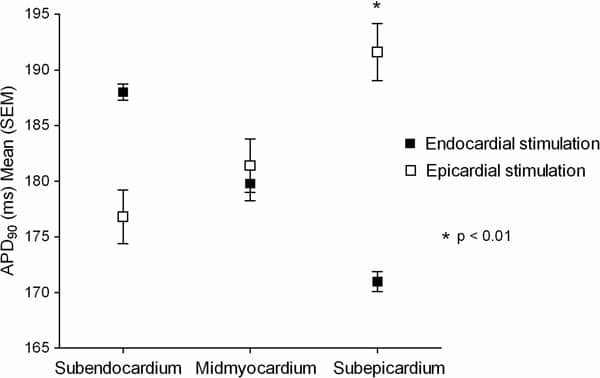Background: Transmural gradients of action potential duration (APD) are known to exist in ventricular cardiomyocytes. This study investigated whether the sequence of activation across the ventricular wall would modulate transmural APD. Methods: New Zealand White male rabbits (n = 5) were killed with an intravenous injection of sodium pentobarbitone (100 mg kg-1). Hearts were removed, and perfused left ventricular wedge preparations were loaded with a voltage-sensitive dye (RH237). An optical mapping system was used to record transmural optical action potentials (APs) during endocardial and then epicardial stimulation at a cycle length of 350ms at 30○C. APs were sampled from points at equal distances between the two bipolar stimulating electrodes, which were arranged perpendicular to the wall. APD90 was calculated as the time from the steepest upstroke to 90% repolarisation. Data are presented as mean ± SEM. Comparisons between mean values for each experiment were made using a repeated measures ANOVA with a Tukey post-test. Results: In each experiment the transmural gradient of APD90 was reversed following a change from endocardial to epicardial stimulation. During endocardial stimulation, mean APD90 was 188±0.7ms at the subendocardium, 179.8±1.6ms at the midmyocardium and 171±0.9ms at the subepicardium (p<0.01 for subendocardium vs. subepicardium). During epicardial stimulation, mean APD90 was 176.8±2.4ms at the subendocardium, 181.4±2.4ms at the midmyocardium and 191.6±1.6ms at the subepicardium (p<0.01 for subendocardium vs. subepicardium). Compared to endocardial stimulation, epicardial stimulation produced a significant lengthening of subepicardial APD90 (p<0.01). In a subset of experiments (n = 3) endocardial stimulation was repeated and the transmural pattern of APD90 reverted to that seen originally. Conclusions: These data demonstrate a reversal of the pattern of transmural APD90 following a change from endocardial to epicardial stimulation, and suggest that electrotonic influences are important in determining transmural heterogeneity of APD.
Life Sciences 2007 (2007) Proc Life Sciences, PC357
Poster Communications: Transmural patterns of action potential duration are altered by activation sequence
R. C. Myles1, F. L. Burton1, S. M. Cobbe1, G. L. Smith1
1. Cardiovascular Research Centre, University of Glasgow, Glasgow, United Kingdom.
View other abstracts by:
Figure 1. Mean transmural APD90 from five experiments during endocardial stimulation (closed squares) and epicardial stimulation (open squares).
Where applicable, experiments conform with Society ethical requirements.

